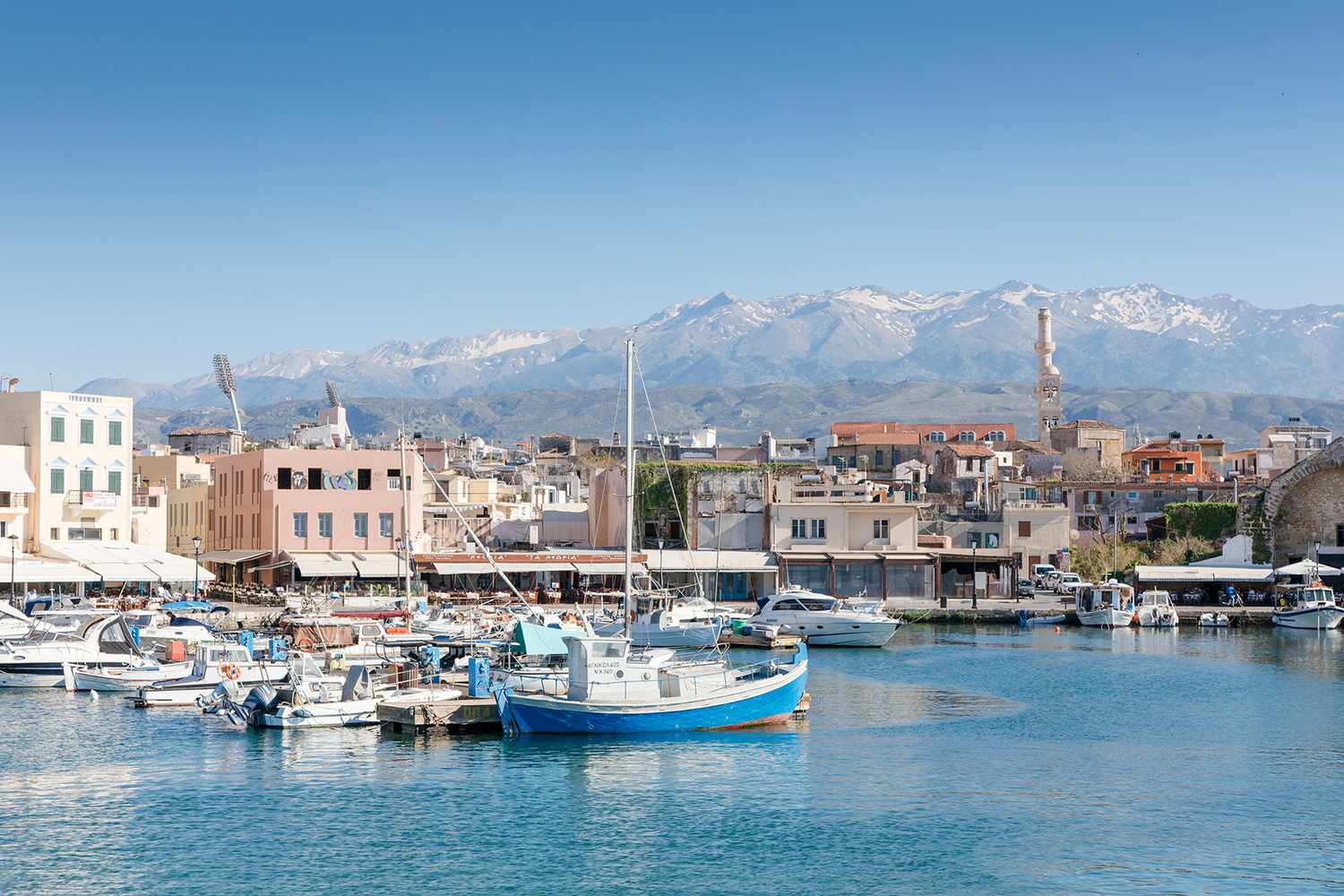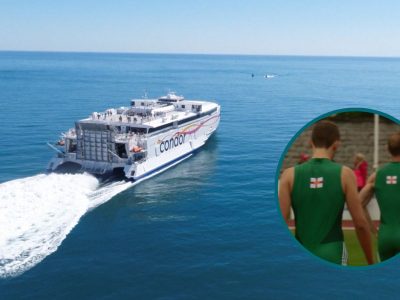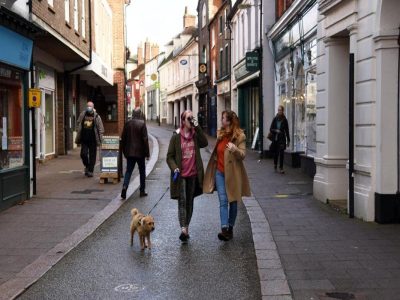Planning a trip to the Greek islands can be intimidating, even for the most seasoned travelers. With more than 200 inhabited isles (and about 6,000 islands and islets in total), the magnitude of the archipelagos is astounding. Each has its own character and aesthetic, from Cyclades islands dotted with white-and-blue houses to the lush and green Ionian Islands to the castle-lined Dodecanese.
Overall, Greece has six main island groups, plus a significant stand-alone: Crete. It’s generally easiest to travel between islands within one group than to hop between archipelagos. In this guide, we’ll break down the best Greek islands to visit, including what each island group is known for, and how to travel within each archipelago.
Getting Around the Greek Islands
While many of the Greek islands have airports, not all of them have international terminals. Many are serviced solely by domestic carriers like Aegean Airlines, and you can only fly from neighboring islands or Athens. However, some of the most popular islands (including Crete and Santorini) have international airports, where you can fly directly from cities in Europe or the Middle East.
Traveling by ferry simplifies island hopping, especially if you’re just exploring one archipelago. In the Cyclades, Seajets is the high-speed ferry, though travelers can find all options (including less expensive ferries) via Greek Ferries. It is possible, of course, to rent a car in Athens — or on one of the islands — and drive it onto the ferry, essentially turning your island-hopping excursion into a seafaring road trip. However, it’s easy to rent a car on the islands, too, provided you have an international driver’s license with you.
When to Visit the Greek Isles
May, June, and late September are great times to travel if you’re looking for nice weather but still hoping to avoid the crowds. The high season (mid-June to mid-September) offers more ferry routes, flight options, and open restaurants and beach bars, but it also means more tourists and higher prices. Each island group has its own weather to look into — Crete is warmest year-round, making it a great choice for late fall or winter. And while some Greek islands, such as Hydra, are full of locals and see tourists year-round, others, such as Santorini, get very quiet in the off-season (November to March). Here, we’ve put together an overview of each group of islands (and the highlights of each archipelago) to help you plan your next Grecian adventure.
The Cyclades Islands
Monica Farber/Travel + Leisure
This archipelago is the most common first stop for American travelers in Greece, with two of the most-visited islands: Mykonos and Santorini. A group of about two dozen inhabited islands (and 220 total isles), this bunch looks like all the postcards of Greece you’ve seen: white churches with blue domes and pink bougainvillea vines shading secluded side streets.
Mykonos is known for its nightlife and see-and-be-seen beaches, but it also has a gorgeous Cycladic village in its center, with windmills and winding lanes designed to confuse pirates centuries ago. Santorini is romantic and luxurious, beloved by honeymooners lounging in their private pools overlooking the caldera. For those looking for alternatives to Mykonos and Santorini, options abound. Up-and-coming Milos has otherworldly beaches and the famed sea caves, Tinos is the site of a famous Church of the Virgin Mary, and the rustic Lesser Cyclades (Koufonisia, Donousa, Schinoussa, and Iraklia) are great for camping. There are large islands, like Naxos and Syros, the archipelago’s capital, and tiny ones with very little tourism, like Sikinos.
How to Travel the Cyclades Islands
The tourist season on the Cycladic islands runs from mid-April to mid-October (peaking in June, July, and August). If it’s your first time in the area, you’ll want to start by visiting Mykonos or Santorini. On Santorini, you’ll find great wineries, like Venetsanos and Santo, while on Mykonos, it’s the nightlife that will keep you coming back, with iconic clubs like Scorpios and Super Paradise Beach Club. When exploring some of the smaller islands, like Ios, Folegandros, and Milos, swim, snorkel, and wander the fortress-like capital of each island. The cobbled alleyways are home to shops, galleries, bars, and tavernas (on most islands the main town is called “Chora”; on Milos, it’s “Plaka”). And don’t miss sailing adventures around the Cycladic islands — look into companies like Polco Sailing on Milos and Sunset Oia Cruises on Santorini.
Where to Stay
On Santorini, start your trip by staying amid the iconic white-and-blue cliffside houses of Oia at Andronis Luxury Suites. Next, move along the caldera to the village of Imerovigli, where you’ll find some of the most over-the-top and romantic hotels, including Andronis Concept Wellness Resort and Grace Hotel, Auberge Resorts Collection. Finally, stay a night in the old town of Pyrgos at Santorini Sky.
On Mykonos, start your vacation at The Wild Hotel by Interni, which has a luxurious boutique atmosphere and a private beach for guests. For an ideal honeymoon in Greece, spend a few exceptionally romantic nights at Kalesma Mykonos, where each suite has its own infinity-edge pool.
Elsewhere in the Cyclades, look for luxury boutique hotels (many, like The Wild and Kalesma, are family owned). Try Milos Breeze on Milos, Coco-Mat Eco Residences on Serifos, Calilo on Ios, and the Naxian Collection Luxury Villas & Suites on Naxos.
Crete
The largest Greek island (and the southernmost, roughly halfway between Europe and Africa), Crete could be its own country. Because there’s so much to explore, many travelers focus their energy on the 160-mile-long island rather than straying to other archipelagos.
How to Travel on Crete
The island has two main airports, making Crete very easy to get to from Athens. Once you’re on the island, it’s a good idea to rent a car; it takes about six hours to drive from one end of Crete to the other.
The island boasts some of the best beaches in Greece, including Elafonissi, with its unparalleled pink sand, and Elounda, known for its five-star beach clubs. Hike the Samaria Gorge (which takes five to seven hours through streams and between cliffs), or walk through wildflowers along paths in the mountain villages. Visit the ruins of the Knossos Palace, home of the Minoan empire (and the dreaded Minotaur monster), and the Boutari Winery if you’re interested in sampling Cretan wines. Finally, if you have time for a day trip, the isle of Spinalonga, off the coast of Elounda, is worth visiting for its wild beauty and tragic history — it was home to a colony of people affected by leprosy until 1957.
Where to Stay on Crete
With picturesque olive groves sloping down to sandy beaches, Elounda has become something of a Cretan Riviera. This stretch along the island’s northeast coast is lined with swanky resorts including Crete’s only Relais & Chateaux property, the Elounda Mare, and the contemporary Cayo Exclusive Resort & Spa.
Outside the island’s capital city of Heraklion is the family-friendly five-star beachfront resort Amirandes, part of the national Grecotel chain (take a detour to have dinner on their farm, Agreco). Moving west, you’ll find the well-preserved Venetian town of Rethymno, and more historic boutique hotel options like Kapsaliana Village Hotel, built around an 18th-century olive oil mill, and Casa Delfino, a renovated 17th-century mansion inside the walled old town of Chania.
Saronic Gulf Islands
The closest island group to Athens is also home to some of the most scenic, under-the-radar isles. Hydra, Spetses, Poros, Aegina, and little Agistri are popular with Greek weekenders and European visitors but are less known to Americans.
How to Travel the Saronic Gulf Islands
The Nantucket of Greece, car-free Hydra is tiny but mighty. Spetses has green pine trees, yachts parked in the harbor, and traditional horse-drawn carriages along its waterfronts. Family-friendly Poros, with tree-shaded beaches and a charming town dominated by a clock tower, is popular among sailing aficionados. Aegina, the closest island to Athens, has a large port town, sandy beaches, and the ancient Temple of Aphaia dedicated to the goddess of Athena. Because the Saronic Gulf islands are so close to Athens, getting here is simple — a hydrofoil from the port of Piraeus ferries you from Athens to each of these destinations.
Where to Stay
Hydra and Spetses are brimming with converted captains’ homes (we like the Cotommatae on Hydra and Orloff Resort on Spetses). On Poros, Sto Roloi is a collection of traditional island houses turned into holiday villas, while Sirene Blue Luxury Beach Resort offers plush suites and villas with access to swimming pools and a private beach. Renting a villa through Five Star Greece is also an option, especially on Aegina where weekend homes outshine the hotels. The crown jewel of the Saronic Gulf is Spetses’ harborfront Poseidonion Grand Hotel, established in 1914, which is just as lavish as its name suggests.
The Ionian Islands
Irjaliina Paavonpera/Travel + Leisure
Lush and green, the Ionian Islands (also known as “Eptanissia” or the “seven islands”) offer unique local culture, music, art, cuisine, and architecture. While the Ionians are known, first and foremost, for Corfu, the six other main islands hold their own and attract their fair share of tourists, too.
How to Travel the Ionian Islands
On Corfu, you’ll want to wander the streets of the island’s UNESCO-protected Old Town. Near Corfu, tiny Paxos is covered in olive trees, with three charming bays and a satellite island, Antipaxos, known for its translucent waters. The largest of the Ionian Islands in size, Kefalonia is one of the most beautiful places to visit in Greece and has semi-wild horses running around Mount Ainos in its center. Zakynthos is home to Navagio Beach (also known as Shipwreck Beach), accessible only by sea, and iconic blue caves you can swim through. Lefkada, connected to the mainland by a bridge, has woodland villages and some of Greece’s best beaches along its shores. Small Ithaka, known to Homer fans as the home of Odysseus, is still relatively undiscovered. Finally, Kythera is the outlier — it looks more Cycladic than Ionian and is more easily reached from the Peloponnese.
Corfu, Kefalonia, Zakynthos, and Kythera all have airports, which receive domestic flights from Athens as well as international charters and airlines.
Where to Stay
On Corfu, options range from stylish seaside resorts like the Grecotel Corfu Imperial to historic 18th-century estates in the Tuscan-like interior such as the Pelecas Country Club. Near the Old Town, the first Banyan Tree Hotels & Resorts property in Europe, Angsana Corfu, offers a gorgeous seaside enclave with 159 rooms and lavish pool villas.
On Kefalonia, the ultra-modern Tesoro Blu is an adults-only oasis just outside the village of Skala, and the Emelisse Nature Resort is a gem outside the picture-perfect town of Fiscardo. Its sister property on Ithaka, the Perantzada, is a contemporary hotel within a 19th-century mansion on the harbor in Vathy. Little Paxos is all villa rentals and rooms to rent except for a few intimate hotels, like Agali Hotel Paxos and Paxos Club Resort & Spa. On Zakynthos, Porto Zante Villas & Spa is a swanky oasis on the busy eastern coast, and in the quiet north of the island, near the blue caves, Nobelos is a four-suite, family-run hotel beloved for its organic restaurant.
The Sporades Islands
There are 24 of these green islands off of the northeastern coast of mainland Greece, but only four are inhabited — and if you’ve seen “Mamma Mia,“ you know what they look like. Dark green pine trees, white churches, and lots of sand, rocks, and singing. It’s all part of the Sporades experience.
How to Travel the Sporades Islands
Buzzy Skiathos is famous for its gold-sand beaches and nightlife, while low-key Skopelos is a natural paradise of white pebble coves, oak forests, monasteries, traditional villages, and lots of shipwrecks off the coast in the National Marine Park of Alonissos and Northern Sporades. Alonissos is at the center of the National Marine Park, a great base for fishing, bird-watching, and spotting the protected Mediterranean monk seal. Finally, Skyros is known for its ceramics and local crafts, churches, and gorgeous Chora, a mountaintop capital crowned by a Venetian castle.
To get to the Sporades, you can fly directly from Athens to Skiathos and Skyros. Skiathos is also served by a ferry from Thessaloniki. In summer, hydrofoils sail to all four islands from the port of Agios Konstantinos on the mainland. You can travel between the islands by ferry or private boat.
On these four islands, tourism is all about sailing, swimming, mountain biking, sea kayaking, and hiking. Hit the beaches — Skiathos’s swanky Ambelakia to see and be seen, Skyros’s Kalamitsa for wind-surfing, Skopelos’s Hovolo for pine-scented breezes. Above all, do not miss sailing, swimming, or scuba diving in the marine park.
Where to Stay
There are villas to rent all over the islands (like the ones with private pools run by Poikilma Villas on Alonissos). For a more full-service hotel, try the family-run Atrium Hotel above Agia Paraskevi beach in Skiathos, or the Adrina Resort & Spa on the beach in Skopelos.
The Northeast Aegean Islands
This collection of more than a dozen islands (the five most notable being Ikaria, Samos, Lemnos, Lesvos, and Chios) is the area of Greece closest to Turkey. For your journey here, you’ll be richly rewarded with incredible beaches and natural wonders (a petrified forest on Lesvos, volcanic rocks and sand dunes on Limnos, and thermal springs on Ikaria).
How to Travel the Northeast Aegean Islands
Lemnos, Lesvos (also known as Mytilene), and Samos all have international airports, and Chios and Ikaria have domestic ones. There are several ferries from the port of Piraeus in Athens that can take you to these islands as well.
Visit the archaeological sites of the Temple of Hera on Samos, the acropolis on Thassos, the ancient city of Ifestia on Lemnos, and the magnificent castle atop Lesvos. While these islands are famous for their history, they’re also known for their water sports. Keros Beach on Lemnos is one of the best places to kite- or windsurf in Europe. As for swimming, it’s hard to beat the Seitani coves on Samos, Kipos beach on Samothrace, white-sand Seychelles on Ikaria, and Vatera on Lesvos.
Where to Stay
Time-travel back to when Genovese nobility ruled Chios and stay at the majestic Argentikon Luxury Suites in a 16th-century estate. Sleep above popular Tsamadou beach at the Armonia Bay Hotel on Samos, overlooking the sea at Toxotis Villas on Ikaria, or on the beach in a luxury safari tent through Surf Club Limnos.
The Dodecanese Islands
This archipelago gets its name from the Greek number 12 (dodeca) because it contains — you guessed it — a dozen main islands and multiple smaller ones. Rhodes and Kos are the two largest islands, while the smaller 10 are quieter and less discovered.
How to Travel the Dodecanese Islands
Rhodes and Kos have international airports (making them popular among travelers who fly in from England and Germany), and Astypalaia, Kalymnos, and Karpathos receive domestic flights. All 12 main islands are served by ferries from the port of Athens, Piraeus.
Rhodes is known for its beautifully preserved walled city with Crusader castles and an ancient synagogue. And in the town of Lindos, there’s an ancient Greek acropolis at the top of the hill, a medieval village in the middle, and a modern town on the beach at the bottom. Highlights on adjacent islands include the mansions of Kasos, the brightly painted houses of Kastellorizo, and the hilltop Chora (historic center) of Astypalea, one of the prettiest fortified villages in all of Greece. For a more active Greek isles experience, retreat to Karpathos to hike or windsurf, or scuba dive amid the World War II wrecks on Leros.
Where to Stay
On Rhodes, soak in the atmosphere at Melenos Lindos, a 17th-century building with a pebbled mosaic roof deck offering sea views, set into the hill just under the acropolis. On Astypalaia, the island’s breathtaking Chora is both the inspiration for, and the location of, Pylaia Boutique Hotel & Spa, which has a pool, spa, and ocean views from the Plori restaurant at its peak. And finally, on Patmos, overlooking the sea (and the famous Kalikatsou rock), The Petra offers luxurious suites equally convenient for the beach and the Monastery of St. John the Theologian.










